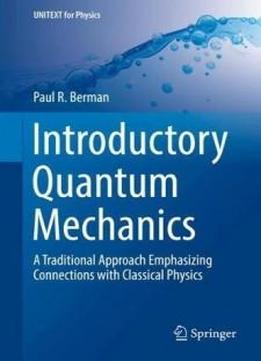
Introductory Quantum Mechanics: A Traditional Approach Emphasizing Connections With Classical Physics (unitext For Physics)
by Paul R. Berman /
2017 / English / PDF
17.2 MB Download
This book presents a basic introduction to quantum mechanics.
Depending on the choice of topics, it can be used for a
one-semester or two-semester course. An attempt has been made to
anticipate the conceptual problems students encounter when they
first study quantum mechanics. Wherever possible, examples are
given to illustrate the underlying physics associated with the
mathematical equations of quantum mechanics. To this end,
connections are made with corresponding phenomena in classical
mechanics and electromagnetism. The problems at the end of each
chapter are intended to help students master the course material
and to explore more advanced topics. Many calculations exploit
the extraordinary capabilities of computer programs such as
Mathematica, MatLab, and Maple. Students are urged to use these
programs, just as they had been urged to use calculators in the
past. The treatment of various topics is rather complete, in that
most steps in derivations are included. Several of the chapters
go beyond what is traditionally covered in an introductory
course. The goal of the presentation is to provide the students
with a solid background in quantum mechanics.
This book presents a basic introduction to quantum mechanics.
Depending on the choice of topics, it can be used for a
one-semester or two-semester course. An attempt has been made to
anticipate the conceptual problems students encounter when they
first study quantum mechanics. Wherever possible, examples are
given to illustrate the underlying physics associated with the
mathematical equations of quantum mechanics. To this end,
connections are made with corresponding phenomena in classical
mechanics and electromagnetism. The problems at the end of each
chapter are intended to help students master the course material
and to explore more advanced topics. Many calculations exploit
the extraordinary capabilities of computer programs such as
Mathematica, MatLab, and Maple. Students are urged to use these
programs, just as they had been urged to use calculators in the
past. The treatment of various topics is rather complete, in that
most steps in derivations are included. Several of the chapters
go beyond what is traditionally covered in an introductory
course. The goal of the presentation is to provide the students
with a solid background in quantum mechanics.











